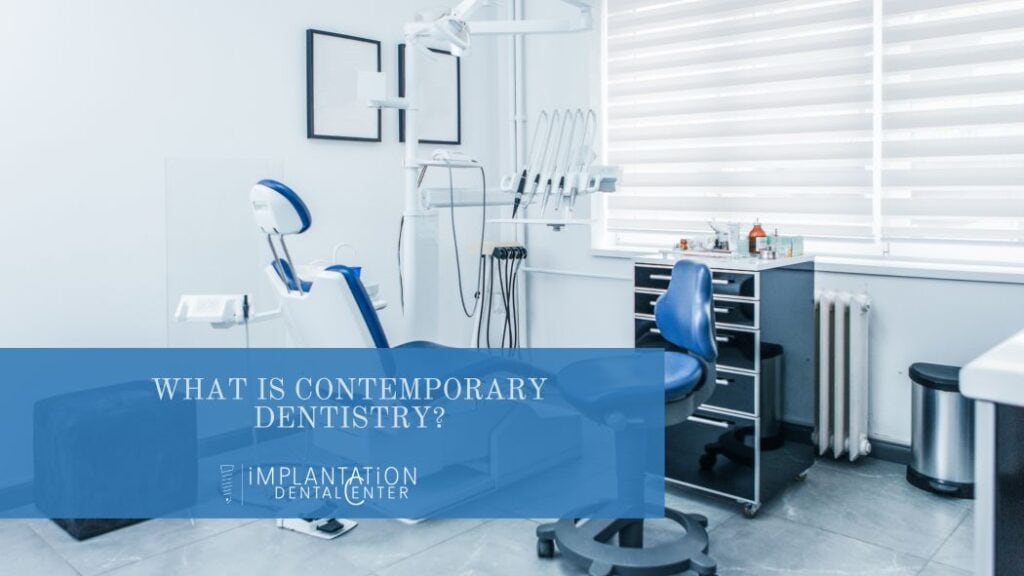Contemporary dentistry refers to the current state and practice of dentistry, which incorporates advanced technology, modern materials, and up-to-date techniques to provide high-quality dental care. It involves a wide range of dental procedures, including preventive care, restorative dentistry, cosmetic dentistry, orthodontics, periodontics, and oral surgery, among others.
In contemporary dentistry, dentists utilize the latest tools and techniques to diagnose, treat, and prevent dental problems, including digital x-rays, intraoral cameras, lasers, and computer-assisted design and manufacturing (CAD/CAM) systems for restorations such as dental crowns and bridges. Additionally, contemporary dentistry emphasizes patient comfort and convenience, with many dentists offering sedation dentistry and same-day treatments.
Overall, contemporary dentistry is focused on providing comprehensive, patient-centered care that promotes oral health, aesthetics, and overall well-being.
What is adhesive dentistry?
Adhesive dentistry is a branch of dentistry that focuses on bonding restorative materials, such as composite resin, to natural teeth. Over the years, there have been significant advances in adhesive dentistry, including the development of new materials and techniques that have improved the durability and aesthetic outcomes of dental restorations.
Here are some of the key advances in adhesive dentistry:
- Universal adhesives: These adhesives can be used with any dental substrate, including enamel, dentin, and metal, making them highly versatile and easy to use. They also offer strong bonding strength and improved durability.
- Self-etch adhesives: These adhesives do not require a separate etching step, as they can simultaneously etch and prime the tooth surface. This results in less postoperative sensitivity and faster placement of dental restorations.
- Bulk-fill composites: These materials allow for the placement of thicker layers of composite resin, reducing the number of layers required to build up a restoration. This saves time and improves the efficiency of dental procedures.
- CAD/CAM technology: This technology allows for the creation of highly precise and accurate restorations, such as dental crowns, inlays, and onlays. The restorations can be milled from a block of ceramic material in a single visit, reducing the need for multiple appointments.
- Digital impressions: These impressions are made using a digital scanner, which creates a 3D image of the patient’s teeth and gums. They are more accurate and comfortable than traditional impressions, and can be used to create highly precise dental restorations.
Overall, these advances in adhesive dentistry have improved the quality and efficiency of dental procedures, leading to better outcomes and higher patient satisfaction.
Translucent zirconia in Contemporary Dentistry
Translucent zirconia is a type of zirconia ceramic material that is used in dentistry to create highly aesthetic dental restorations, such as crowns and bridges. Unlike traditional zirconia, which has a more opaque appearance, translucent zirconia has a high level of translucency that mimics the natural appearance of teeth.
Translucent zirconia is made by adding small amounts of other materials, such as yttrium oxide, to the zirconia powder, which increases the material’s translucency. The resulting material has a translucency that is similar to that of natural teeth, making it an ideal choice for dental restorations where aesthetics is a primary concern.
One of the main advantages of translucent zirconia is that it can be used in a variety of dental applications, including anterior and posterior restorations. It is also highly durable, resistant to wear and fracture, and biocompatible, making it a safe and effective material for dental restorations.
Overall, translucent zirconia is an excellent option for patients who are looking for a highly aesthetic and durable dental restoration that closely resembles their natural teeth.
What are minimally prepared teeth?
Minimally prepared teeth, also known as minimally invasive dentistry, is an approach to dental treatment that focuses on preserving as much natural tooth structure as possible while still achieving the desired treatment outcome. The goal of minimally prepared teeth is to minimize the amount of tooth structure that is removed during dental procedures, which can help to preserve the integrity and strength of the tooth.
The minimally prepared teeth approach involves using a variety of techniques and materials to achieve the desired outcome with minimal tooth reduction. For example, in the case of dental fillings, dentists may use composite resin materials that can be bonded to the tooth, rather than traditional amalgam fillings that require more extensive tooth preparation. In the case of dental crowns, minimally prepared teeth may involve the use of materials like translucent zirconia or ceramic, which require less tooth reduction than traditional porcelain-fused-to-metal crowns.
The benefits of minimally prepared teeth include less trauma to the tooth, less pain and discomfort during and after the procedure, and a faster recovery time. Additionally, because less tooth structure is removed, the tooth is better able to maintain its natural strength and resilience, which can help to prevent future problems.
Overall, minimally prepared teeth is an approach to dental treatment that prioritizes the preservation of natural tooth structure while still achieving the desired treatment outcome. It can help to minimize the risks and side effects associated with traditional dental procedures and can lead to better long-term outcomes for patients.
Dr. Hervas treats every patient with the goal of preserving their existing teeth as much as possible, while keeping the end goal in mind. We invite you to contact our dental office in Plantation, Florida to begin your dental restoration journey.



